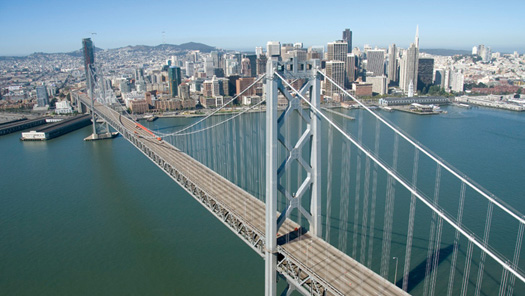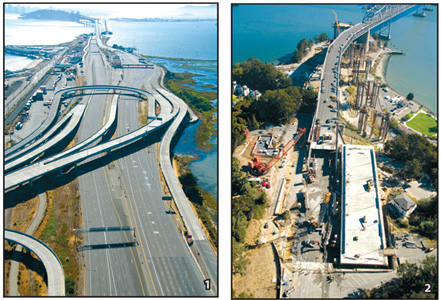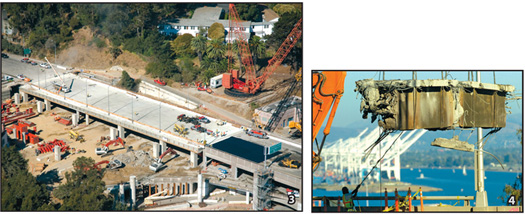So smooth, it was like sliding in a drawer. That’s how one local news organization described the delicate process of rolling in a new 6,500-ton segment of the upper deck of the San Francisco-Oakland Bay Bridge over Labor Day weekend. The operation also was remarkably fast, with the installation taking a little under three hours, about half the time originally predicted. In fact, nearly every aspect of the complex retrofit-by-replacement just to the east of the Yerba Buena Island Tunnel was so well-orchestrated that Caltrans and the Bay Area Toll Authority (BATA) were able to shave 11 hours off the schedule, and reopen the bridge to traffic at 6 p.m. on Labor Day proper – far ahead of the original deadline of 5 a.m. on Tuesday.

Tricky Labor Day Operation Races to Early Finish
By Brenda Kahn
Published: October, 2007
There were many heroes helping to deliver the tricky project, not the least of which were the 250 or so intrepid construction workers, truck drivers and big-equipment operators who toiled around the clock over the three-day weekend. Then there’s the man presiding over it all, C.C. Myers, the larger-than-life figure who heads the construction firm that bears his name.
We’re risk takers, but we always make our schedules, said a confident Myers on the Saturday afternoon of the three-day operation, no doubt referring to his firm’s near-miraculous performance in speedily rebuilding a key element of the fire-damaged MacArthur Maze in Oakland this past May. Behind him, crews worked at a fast clip with massive mechanical claws and equally massive jackhammers to demolish old deck section and haul away the multiton chunks of rebar-and-concrete debris. The challenging task required precision aim to avoid damaging the new deck columns standing just a few feet away from the old deck.
Kudos also are due to the Caltrans public information staff, who did their utmost to alert travelers up and down the state about the bridge closure well in advance of the Labor Day weekend, and to the transit operators that beefed up service, particularly the ferry systems and BART. Bay Area residents did their civic duty by cutting back on driving and hopping on transit to partake of the weekend’s rich cultural offerings, from a Summer of Love commemorative concert in Golden Gate Park to the Art & Soul festival in Oakland.
BART, which took the unusual step of offering all-night service to 14 stations, reported record ridership over the weekend. While there were some bottlenecks here and there, Bay Area freeway travel was relatively light, and the doomsday scenario of regional gridlock never materialized.
By late Sunday evening, crews had carved a neat, football-field-sized hole out of the upper deck, and had laid rails across the lower deck. Just after midnight, the new steel rebar-and-concrete slab, which had been built over a period of several months to the south of the existing deck, started to roll across the rails with a slim margin of a mere three inches on each side.
The new viaduct to the tunnel improves the seismic safety of the current bridge, and eventually will hook up to the new East Span that’s under construction to the north of the existing bridge, said Andrew Fremier, deputy director for BATA, which is staffed by MTC.
Taking advantage of the extended bridge closure, BATA and Caltrans staff used the holiday weekend to reconfigure the toll plaza, adding a peak-hour FasTrak®-only lane (for a total of eight) and extending striping so as to separate cash payers from those paying their tolls electronically a full 2,600 feet back from the toll plaza, a distance that is more than four times longer than the previous approach. Newly installed signage also will help guide drivers to the correct lane, and minimize weaving.
At 2 p.m. on Monday — Labor Day proper — Caltrans and BATA held a press conference where they made a dramatic announcement: Instead of requiring the full 81 hours allotted for the job, the bridge would open by 6 p.m. that day, just 70 hours from the start of construction. With the announcement, the few glitches that had threatened the operation, from a shortage of trucks to haul away debris, to tougher-than-expected rebar that slowed the initial demolition, faded into distant memory.
It was an amazing accomplishment, said Caltrans Director Will Kempton.
Photo Album
Normally the busiest bridge in the region, the Bay Bridge was eerily devoid of traffic over Labor Day weekend due to a three-day closure to allow two critical projects to proceed: the replacement of a key section of the East Span upper deck, and the reconfiguring of the toll plaza. This page, clockwise starting at upper right corner: 1) The Bay Area Toll Authority and Caltrans restriped the Bay Bridge approach to separate FasTrak® users from cash-payers further downstream from the toll plaza. 2) Crews excavated a football field-sized chunk of the upper deck to make way for the new piece. 3) By early Monday morning, the new, seismically stronger deck piece was rolled into place. 4) A temporary truck shortage slowed the hauling of the massive debris.
Credits: All aerial photos on pages 12 and 13 © 2007 Barrie Rokeach, www.rokeachphoto.com; close-up photo of debris chunk by Noah Berger.



